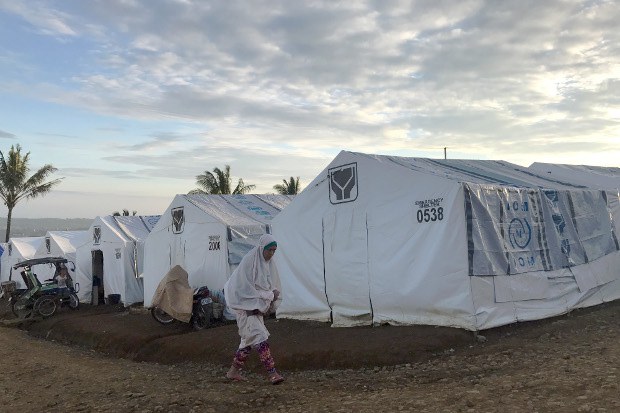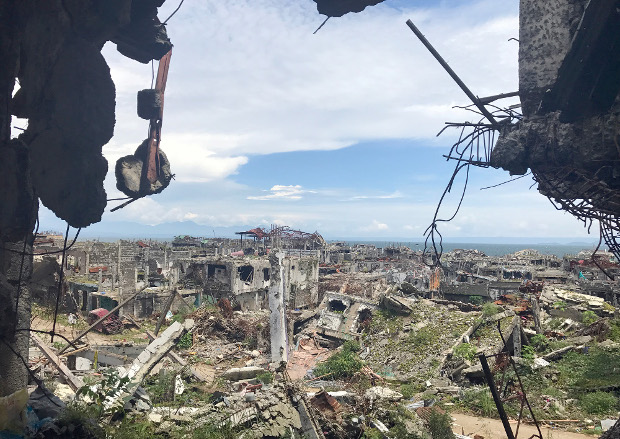10 Months after Marawi Siege, 69,000 Residents Still Displaced: UN
2018.08.09
Cotabato and Iligan, Philippines
 An evacuee walks near a temporary shelter for Marawi refugees in the southern Philippine province of Lanao del Sur, June 15, 2018.
An evacuee walks near a temporary shelter for Marawi refugees in the southern Philippine province of Lanao del Sur, June 15, 2018.
Tens of thousands of Filipinos driven out of their homes in the southern Philippine city of Marawi remain displaced almost 10 months after Philippine security forces defeated pro-Islamic State militants in five months of vicious fighting, the United Nations said Thursday.
The United Nations Office for the Coordination of Humanitarian Affairs (OCHA) said that 69,000 people were still staying in evacuation centers and transitional sites in Lanao del Sur province because parts of Marawi remain uninhabitable.
An estimated 320,000 people have returned to Marawi since President Rodrigo Duterte declared the fighting over in October, the UN said. This figure is contrary to earlier census estimates that Marawi only has a population of slightly over 200,000.
“For those who have returned, there is still a long road ahead,” Mark Bidder, OCHA head in the Philippines, told reporters.
So far, he said, the government’s response has yielded positive results, with Marawi villages and other nearby towns working to address protection concerns.
But Bidder said authorities were concerned about school age-children “who are at risk of dropping out of school, recruitment by extremist groups, and exposure to increasing poverty.”
“A priority for returnees is decent employment and sustainable livelihoods, which would contribute to stabilizing incomes, enhancing security and initiating long-term socio-economic recovery,” he said.
Traders turn to farming
Social welfare secretary Virginia Orogo said that authorities have been providing livelihood support to the displaced, and that fund releases to the displaced have been prioritized.
“We have already submitted documents for the release of the transitory family support package and livelihood settlement grants to our partners,” Orogo said.
Almaira Abdulrahman, one of those displaced by the war, expressed optimism that the government’s support would continue until refugees can recover from the devastation.
“All my life, I never thought that I would experience this kind of tragedy,” she said. “I thank the government. They are the ones who supported our needs for food, and now, for capital that can be used for a small business.”
But the International Committee of the Red Cross (ICRC) said many families transplanted to parts of Lanao del Sur province continue to struggle due to lack of food and other necessities.
Dragana Rankovic, who heads the ICRC team on relief and livelihood assistance in Mindanao, said the absence of a stable income and capital for small businesses has forced many who were traders before the start of the conflict to rely on farming and fishing.
“Many displaced families gained access to farmlands and basic tools with the help of relatives. But insufficient funds to buy farm supplies forced them to take loans at a higher interest rate,” Rankovic said.

Security situation better but concerns remain
The Marawi gunbattles began on May 23 last year when the local IS faction led by Isnilon Hapilon laid siege to the Philippines’ only predominantly Islamic city. More than 1,200 people, most of them militants, died in the vicious fighting that, according to the U.N. refugee agency, displaced at least 360,000 residents.
With fighters from Southeast Asia and the Middle East, Hapilon’s group took dozens of hostages, destroyed a Christian church and beheaded an undetermined number of people as they engaged troops in vicious street-by-street battles and used Muslim mosques as hiding areas.
But the Philippine military, aided by U.S. and Australian intelligence spy planes, used fighter jets and pounded the militants with artillery, killing Hapilon and other militant leaders, effectively ending the siege that began five months earlier.
But President Rodrigo Duterte has said that many IS fighters had escaped at the height of the gunbattles, and could be plotting attacks elsewhere.
Military rule is still in effect in the entire southern Mindanao region. While access to Marawi and the security situation has considerably improved, the recent emergence of groups claiming to be affiliates of the IS remains a concern, military officials said.
Last week, the IS claimed responsibility for a suicide bomb blast that killed the suspect and 10 people in the outskirts of Lamitan city, in the southern province of Basilan.
Interior Undersecretary Eduardo Ano, a former armed forces chief of staff, said there was no conclusive evidence IS plotted the bombing, although he told the Associated Press on Thursday that a foreign militant was behind the powerful blast that was targeted at a big public gathering.







